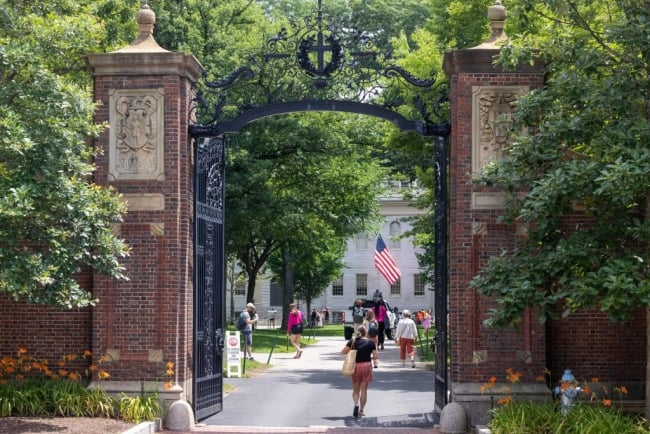You have /5 articles left.
Sign up for a free account or log in.

Harvard University is now the subject of an Education Department civil rights investigation over legacy preferences. But some worry that ending the practice won’t do much for socioeconomic diversity at the nation’s most elite institutions.
Scott Eisen/Getty Images
As the tremors of the Supreme Court’s decision to strike down affirmative action continue to reverberate across higher education, legacy admits are poised to become the next domino to fall.
Yesterday the Education Department opened a federal civil rights investigation into Harvard University’s policy of preferential admissions treatment for the children of alumni. The move came after a coalition of interest groups led by the Boston-based Lawyers for Civil Rights filed a complaint arguing that the practice illegally discriminates against students of color in favor of wealthy, less qualified applicants.
Nicole Rura, Harvard’s senior communications officer, confirmed that the Office for Civil Rights had notified the university of the investigation. But she said that even prior to the announcement, Harvard had been engaged in an internal review of its admissions practices in light of the affirmative action ban.
“Following the Supreme Court’s recent decision, we are in the process of reviewing aspects of our admissions policies to assure compliance with the law and to carry forward Harvard’s long standing commitment to welcoming students of extraordinary talent and promise who come from a wide range of backgrounds,” she wrote in an email to Inside Higher Ed.
A handful of other institutions are voluntarily eschewing legacy preferences, including the University of Minnesota–Twin Cities and Wesleyan University, which put an end to their policies last week.
Wesleyan president Michael Roth said he’d been angling to end his institution’s policy of alumni preferences for years, calling it a “no-brainer” in light of the court decision.
“It seems to me that if we’re going to be saying we want a very diverse campus in the future—abiding by the law but working even harder to recruit Pell-eligible students and doing all these other things to increase diversity—and we still said, ‘Yes, we can give alumni a preference,’ that would make us hypocrites,” he said.
But some experts believe that ending legacy admissions, while an important step, won’t significantly lower the barrier that even high-achieving students from low- and middle-income families face when applying to elite institutions.
It’s not just that more economically advantaged applicants have more resources and are better prepared to meet selective institutions’ high standards. Wealthier applicants also frequently beat out poorer competitors who have even better test scores and GPAs—whether they have an alumni relative or not.
“If they remove legacy preferences and change nothing else, more than likely the new students who are enrolled would look very similar to legacy students; they just might not have a parent who attended that institution,” said Dominique Baker, a professor of education policy at Southern Methodist University who focuses on higher education. “I think it makes perfect sense to end legacy preferences. But something can be a good thing to do and also not necessarily increase the enrollment of Black, brown and Indigenous students.”
The Wealth Wedge
On Monday, researchers at Harvard University released a startling report showing that wealth has long been a significant factor in admissions at highly selective institutions. Among applicants to the top dozen colleges with the same standardized test scores, those whose families were among the top 1 percent of U.S. wealth earners were 34 percent more likely to be admitted.
The report, which used data from 1999 to 2015, also found that the “Ivy Plus” colleges—the eight Ivy League institutions along with the Massachusetts Institute of Technology, Stanford University, the University of Chicago and Duke University—gave preference to legacy applicants and frequently ranked those who attended private high schools higher on nonacademic scores.
That the ivory towers open their gates more often to the scions of wealthy families is no surprise. But the report, produced by the research group Opportunity Insights, illustrates just how much money matters during the admissions process, a revelation that sent waves of alarm through the higher ed world.
“What the study is demonstrating is that there is already class-based affirmative action at elite institutions. It’s just affirmative action for the rich,” said Richard Kahlenberg, a nonresident scholar at Georgetown University’s Center on Education and the Workforce. “It exposes the deep unfairness of admissions at these institutions … the question then becomes, how do you hold colleges accountable for that kind of behavior?”
Rura, of Harvard, said the report will help inform the university’s “efforts to attract and support a community of outstanding students whose educational opportunities are not constrained by financial circumstances.”
Princeton University president Christopher Eisgruber stressed that his university had made strides toward increasing access for low-income students since 2015, when the report’s data end. The university has more than doubled the percentage of students eligible for Pell Grants, from 9.3 percent in 2011 to over 20 percent in 2022. It has also cut the percentage of students from the top 10 percent of wealth earners by 15.7 percent since 2002, according to data provided by the university. (This paragraph has been updated to correct the figure by which Princeton cut the share of top wealth earners.)
But Eisgruber conceded that elite institutions like his have ample room to improve and can do so in part through admissions practices, though he did not endorse or address ending legacy preferences.
“We believe that talent exists in every sector of the American income distribution,” he wrote in an email to Inside Higher Ed. “To achieve our scholarly and teaching mission, we need both to attract that talent and enable it to flourish here. I am proud of what we have done to increase socioeconomic diversity at Princeton, but I also believe that we need to do more—and we will.”
Beyond ending legacy admissions, other practices could also have a profound impact on the socioeconomic makeup of elite institutions’ student bodies. Last month Duke, one of the universities included in the Opportunity Insights study, announced it would offer free tuition to low- and middle-income students from North and South Carolina.
And a spokesperson for Princeton said the university had adjusted some of its admissions practices to be more cognizant of the opportunity and resources gap between the haves and the have-nots, including by “recognizing overcoming socioeconomic disadvantage as a direct indicator of potential success” among students who have, for example, held down a job or cared for family members while in high school.
Princeton also plans to further expand its transfer program for community college students, which it doubled in size last year. Wesleyan is interested in similar transfer partnerships with community colleges, which Roth said more selective institutions should consider in lieu of affirmative action.
‘More Than a Symbol’
But even the most stalwart proponents of increased access to elite institutions say that addressing wealth disparities is crucial, and ending legacy preferences is an important part of that effort. That’s especially true among universities that have admitted legacy applicants who fell below normal academic standards.
“Creating a class at Wesleyan is like curating a show at a museum: we do it very carefully; we want a diverse array of talent. But now we’re going to take a board member’s kids’ work and put it in the biennial, because loyalty is important?” Roth said. “That’s how the mafia do things. I actually think it’s pretty obscene.”
Kahlenberg believes that ending legacy preferences is “far more than purely symbolic.”
“These are preferences that have a real bite to them. You hear colleges say they’re just used as tie breakers, but that’s just not true,” he said. “At some institutions, there are more legacy students than Black students.”
Kahlenberg also said that while ending legacy preferences is merely the first step in a long list of actions elite institutions should take to increase socioeconomic diversity, downplaying its significance can be detrimental to its success.
“In a perverse way, the argument that it doesn’t solve the whole problem can be used as an excuse to retain legacy preferences,” he said. “I find that deeply troubling … legacy preferences are a form of ancestry discrimination, and they need to go.”
The Education Department may or may not come to a similar conclusion at the end of its investigation of Harvard’s admissions practices. So might Congress, where a bill to disallow legacy or donor preferences at any institution that receives federal funding has been under consideration for over a year.
Regardless of the various legal challenges facing legacy admissions, Roth said he believes Wesleyan is just the first private, elite college to end legacy preferences in the post–affirmative action world. But he cautioned against laying all the blame for socioeconomic disparity at elite institutions on the trembling shoulders of alumni preferences.
“I hope there will be pressure on more schools to [end legacy]. But I also hope we can keep turning the conversation to the question of, why aren’t more high school graduates prepared to be successful in places like Amherst [College] and Wesleyan and the Ivies?” Roth said. “Why are so many people deprived of a decent high school education so that they can’t compete?”
For Kahlenberg, this question is both important and potentially obfuscating. In the short term, he said, nothing should stop selective universities that want to respond substantively to affirmative action’s demise from taking the “important first step” of ending legacy preferences.
“Honestly I get nervous when elite higher education institutions point the finger at K-12 schools and say, ‘Well, that’s the real problem,’” he said. “On one level, of course they’re right that we don’t provide genuine equal opportunity in public education … on the other hand, you don’t want to let colleges off the hook.”





